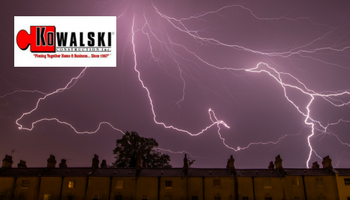
The last few monsoon seasons seemed more like “non-soon” seasons. The lack of our typical storms, however, can lull us into a sense of complacency. Let me remind you of some of our not-so-typical monsoon weather in recent years: we had tornadoes in Flagstaff and Tonapah, and there were 14 dust storms throughout the summer. While dust storms may not seem ominous, they can rise thousands of feet into the air, achieve speeds of 50 mph, reach lengths of 100 miles long and travel for hours. In one dust storm alone, three people were killed and dozens of others injured. Additionally, we average approximately ½ million cloud-to-ground lightning strikes each year. Lightning can produce 1 billion volts, reaching 50,000 degrees Fahrenheit, which is four times greater than the temperature on the surface of the sun.
The general operational criteria for the onset of monsoon conditions prior to 2008 was three consecutive days of dew points averaging 55° or higher. Since then, monsoon season has been established to be between June 15th and September 30th. This season brings us about half of our total annual rainfall. In fact, on September 14, 1969, 3 ½” fell on Tempe in 1 hour alone, maintaining the record for over 40 years.
Summer monsoon thunderstorms can bring very strong and gusty winds, heavy downpours, hail, blowing dust and dangerous lightning. Flash flooding associated with intense thunderstorms is fairly common across the desert, as dry washes tend to fill up quickly. As these thunderstorms subside, microbursts producing severe thunderstorm wind gusts are quite common.
PROPERTY DAMAGE
Not only can these storms cause severe property damage, but they can also threaten lives. Preparedness is the key in getting your property ready for a monsoon storm. Here is a top-to-bottom approach of some things you can do:
-
Instruct your landscapers to confirm the overall health of your trees, especially those near structures. Unhealthy or dead trees and branches can cause serious damage from high-speed monsoon winds. After careful evaluation, consider proper trimming or even removal to reduce potential damage.
-
Inspect and repair any loose and dislodged roofing. Tile is heavy and, if it falls off a second- or third-story roof, can impact with substantial force. When the wind finds a weak spot, it can “peel” back roofing and create a domino effect, resulting in a larger repair area. Wind can blow roofing material a long distance into pools, through windows, and against stucco and siding. Missing roofing also increases the chances for water intrusion and potential mold growth inside the structure.
-
Keep your gutters and downspouts free from debris that could impede water flow. Since the monsoon can bring a much higher amount of rainfall in a shorter period of time, even a small obstruction can cause them to back up and function improperly. This could direct water to the very area that you were trying to divert it away from.
-
Inspect your doors and windows and repair as necessary. Ensure your weather stripping, caulking, seals and thresholds are in good shape to avoid water intrusion. Re-secure, repair or replace any problem items.
-
Remove the accumulation of landscaping debris such as leaves, trash or material that prevents proper drainage away from the foundation. This debris can cause water to divert back toward the foundation, potentially undermining footings and allowing water to enter the structure through capillary action. Clean out any drains, drainage grates or dry wells of accumulated debris to help prevent flooding. These drainage systems can easily become overwhelmed from minor debris accumulation with our heavy monsoon downpours.
Many items can become unintended projectiles and cause severe damage. Properly secure smaller storage buildings. Carport awning structures previously damaged from vehicle impact may appear to only have cosmetic damage until put to the test against high monsoon winds. Inspect and repair perimeter, privacy, security and mechanical fencing and gates. Temporary signs, trellises or furniture, such as poolside tables and chairs, may not appear to pose a threat until a storm strikes.
Water intrusion can cause both interior structural damage and damage to your residents’ and tenants’ contents. While the focus of this article is prevention, some damage is unavoidable. You can help protect their personal property not only by following these guidelines, but also reminding them about securing their own insurance.
Be sure to check out Kowalski Construction in our Vendor Directory!
Not yet a member?
Kick start your multifamily career into overdrive by creating your FREE Multihousing Friends account today!

Jim Kowalski
Since 1979, Jim’s presence within the industry is known nationwide. Serving on many Boards over the years including; National - Restoration Affiliates, National Institute of Disaster Restoration (Restoration Industry Association) State - Arizona Multihousing Association, UMOM, The Future is Now Foundation and countless Industry Association Committees most always in a leadership or Chair role providing him the opportunity to win State Associations Industry Partner of the Year Award on several occasions.
He is a frequent national/state/local speaker/presenter/instructor.
Jim generously gives back to the community volunteering for a number of worthwhile causes, his favorite of which is UMOM where he has served on the board since 2008 and is the current Immediate Past President. He is also a Multihousing Friends contributor.
